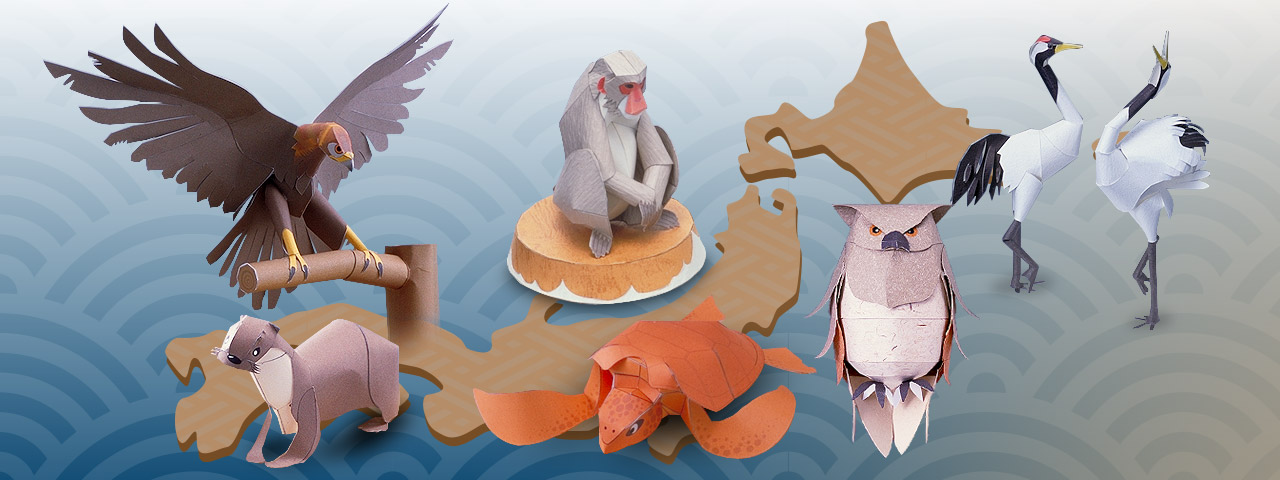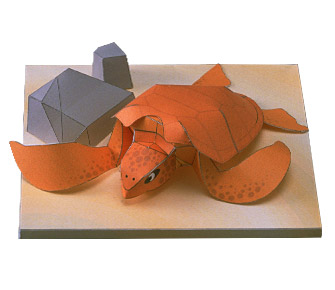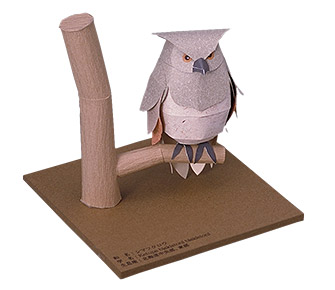Japanese Macaque
Papercraft kit : Japanese Macaque, inhabits the coldest region in the world.

The Snow Monkey of Shimokita Peninsula inhabits the northernmost region of Japan's main island, which is the world's coldest spot inhabited by primates (excluding humans). The species has a short tail despite the fact that it belongs to the “old-world” monkey family, which is characterized by a long tail. The Snow Monkey of Shimokita Peninsula is currently classified in the Red List as a “Threatened Local Population [LP]” species.
Assembly instructions for paper sculptures of the Snow Monkey of Shimokita Peninsula, as well as photo images of completed sculptures may be downloaded from this web site.
Download - Parts sheet & InstructionsThis data was released in January, 2000.
Japanese Macaque - Animal Guide

- Japanese Macaque - Cercopithecidae
- Macaca fuscata fuscata
- 50 to 60 cm (20 to 24 in.) long
- RED DATA BOOK (RDB) categories : Threatened Local Population [LP]
The Japanese Macaque (Macaca fuscata fuscata)is a subspecies of the Japanese Monkey or Hondo Monkey and is a member of the Macaca family of the long-tailed monkey group. However, unlike other Macaca monkeys like the Taiwan monkey and the crab-eating monkey, it is characterized by its short tail reaching no more than 10 centimeters (4 inches) in length. The monkey has a ruby-colored face and rump due to the visibility of capillary blood color through the skin surface. The color becomes more apparent during the mating season, from autumn to winter. In spring the female monkey gives birth to an infant weighing about five hundred grams (approximately one pound). Japanese macaques are territorial, living together in groups of twenty to a hundred and fifty or more, under the strong leadership of a dominant male.
Among the Japanese Macaque inhabiting various regions throughout Japan (excluding Hokkaido), those inhabiting the Shimokita Peninsula can endure the harshest environmental conditions where the temperatures drop as low as 10 degrees below zero Celsius (14 degrees Fahrenheit) in midwinter. The northern monkey, unlike the southern monkey, is believed to be capable of coping with the severe temperatures due to its relatively large size and long, dense fur coat. The Japanese Macaque has cheek pouches where it can temporarily store food. The animal eats mainly on fruit, seeds, leaves, and tree bark but will also eat crabs and insects, such as grasshoppers.


Habitat
The Japanese Macaque inhabits various regions throughout Japan excluding Hokkaido. The species is believed to have learned to adjust to the severe climate by gradually extending its habitats from warm areas, such as Kyushu Island, to northern areas over a long period of time. The macaques of Aomori Prefecture, called "monkey of the northernmost point," are known to be particularly rare. With the exception of human beings, these are the primates that inhabit the northernmost latitudinal region. It is also widely considered to be an academically valuable subject and was designated by the Japanese government as a natural treasure of the nation in 1970.
The Japanese Macaque is currently being spotted in mountainous areas in the northwestern region of Shimokita Peninsula and coastal areas in the southwest. However, its number in the wild has diminished due to the increasing destruction of the natural environment. Problems have arisen from the monkey ravaging crops on farms in their search for food, but the origin of this problem is the cutting of the forests that are its natural habitat.


Photographed by Shiro Matsuoka
About RED DATA BOOK
The Red Data Book is a report compiled by the Environment Agency classifying various threatened animals in Japan and their present status. From a biological viewpoint, the Environment Agency has evaluated the extinction risk level of each individual taxon and compiled a list for the Red Data Book. However, the Book possesses no legal power to enforce regulations concerning threatened species.
The Red Data Book is broadly employed as fundamental information for advancing the preservation of threatened wild animals.
| EXTINCT | EX | A taxon considered to have become extinct in Japan. |
|---|---|---|
| EXTINCT IN THE WILD | EW | A taxon known to survive only under conservation or in captivity. |
| CRITICALLY ENDANGERED | CR | A taxon facing an extremely high risk of extinction in the wild in the immediate future. |
| ENDANGERED | EN | A taxon facing a very high risk of extinction in the wild in the near future though not critically endangered. |
| VULNERABLE | VU | A taxon facing a high risk of extinction in the wild in the medium-term future though not critically endangered or endangered. |
| NEAR THREATENED | NT | A taxon which can qualify for VULNERABLE in the future depending on its habitat conditions, although it is not facing a high risk of extinction at this present stage. |
| DATA DEFFICIENT | DD | A taxon about which there is not adequate information to make a direct, or indirect, assessment of its risk of extinction. |
| THREATENED LOCAL POPULATION | LP | A taxon facing a high risk of extinction in a certain locality among its limited specific habitats. |
From Environment Agency press materials










